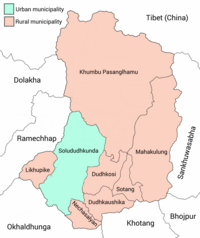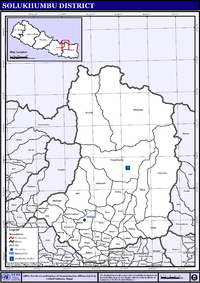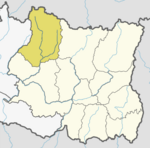Khumbu District
The district, with Salleri as its headquarters, covers an area of 3,312 km (1,279 sq mi) and had a population 107,686 in 2001 and 105,886 in 2011.
Mount Everest is in the northern part of this district, within Sagarmatha National Park.
History
Historically, Solukhumbu was part of Kirata Kingdoms in early and medieval era. It was a part of Majh Kirat Khambuwan (central province or region of Kirat Kingdoms).
Before the unification of Nepal by king of Gorkha, what is now Solukhumbu district was part of Chaudandi of Majh Kirat (Khambuwan). In 1773 AD the King of Gorkha attacked and absorbed it into Nepal.
The Solukhumbu district was established in 1962, out of the old East No. 3 district. Before 1962, present-day Solukhumbu, Okhaldhunga and some parts of Khotang previously constitute district "East No. 3". Solu and Rawa thums (counties) were carved out of East No. 3 to create Solukhumbu District.
-
East No. 3, a district of Nepal before 1962.
-
VDCs of Solukhumbu before 2015.
Geography
Solukhumbu is one of three Himalayan districts within Province No. 1, positioned on the west-by-northwestern corner of the province. It spans a total area of 3,312 square kilometres (1,279 sq mi). It is geographically situated between latitudes 27°20'39" and 28°6'24" North, and longitudes 86°0'21" and 87°0'1" East. Its north border includes the world's highest peak 8,848 metres (29,029 ft) (Mount Everest); and the district's lowest point is at 600 metres (2,000 ft) (Tuintar) above sea level. The district is bordered by Sankhuwasabha in the east, Bhojpur in the south-east, Khotang and Okhaldhunga in the south, Bagmati Province in the west and Tibet (China) in the north.
The diverse geography of Solukhumbu district is marked by three distinct levels:
Khumbu Himal (Highland mountains)
This region is home to the Mahalangur Himal and other Himalayan mountain ranges. Situated on the northern border with Tibet, it hosts some of the world's highest peaks, including Mount Everest (8,848m), Lhotse (8,516m), Makalu (8,485m), Cho Oyu (8,201m), Gyachung Kang (7,952m), among others.
Khumbu region (Highland valley)
Known globally for its trekking and hiking opportunities, the highland Khumbu valley is predominantly inhabited by the Kulung and Sherpa communities. The administrative division of Khumbu Pasanglhamu is located in this region, encompassing the roadless town of Namche Bazaar and villages such as Thame, Khumjung, Pangboche, Pheriche and Kunde. The renowned Buddhist monastery at Tengboche also falls within the Khumbu region.
Solu region (Mid-hills)
Lower Solukhumbu (lower parts of Solukhumbu District) is part of the Mid-hills region. It is less famous for trekking, however new trails such as the Mundhum trail are being developed. Rais are the main inhabitants in this region.
Climate
| Climate Zone | Elevation Range | % of Area |
|---|---|---|
| Upper Tropical | 300 to 1,000 meters 1,000 to 3,300 ft. |
0.7% |
| Subtropical | 1,000 to 2,000 meters 3,300 to 6,600 ft. |
9.3% |
| Temperate | 2,000 to 3,000 meters 6,400 to 9,800 ft. |
20.6% |
| Subalpine | 3,000 to 4,000 meters 9,800 to 13,100 ft. |
16.6% |
| Alpine | 4,000 to 5,000 meters 13,100 to 16,400 ft. |
28.3% |
| Nival | above 5,000 meters | 24.4% |
| Climate data for Salleri | |||||||||||||
|---|---|---|---|---|---|---|---|---|---|---|---|---|---|
| Month | Jan | Feb | Mar | Apr | May | Jun | Jul | Aug | Sep | Oct | Nov | Dec | Year |
| Mean daily maximum °C (°F) | 23.1 (73.6) |
25.8 (78.4) |
31.0 (87.8) |
35.1 (95.2) |
35.0 (95.0) |
34.9 (94.8) |
32.5 (90.5) |
32.8 (91.0) |
32.5 (90.5) |
31.6 (88.9) |
29.0 (84.2) |
24.8 (76.6) |
30.7 (87.2) |
| Mean daily minimum °C (°F) | 9.2 (48.6) |
11.0 (51.8) |
15.1 (59.2) |
19.4 (66.9) |
21.2 (70.2) |
22.9 (73.2) |
23.8 (74.8) |
24.2 (75.6) |
23.8 (74.8) |
21.2 (70.2) |
15.8 (60.4) |
10.6 (51.1) |
18.2 (64.7) |
| Average precipitation mm (inches) | 1 (0.0) |
1 (0.0) |
1 (0.0) |
2 (0.1) |
4 (0.2) |
7 (0.3) |
16 (0.6) |
12 (0.5) |
10 (0.4) |
3 (0.1) |
0 (0) |
1 (0.0) |
58 (2.2) |
| Source: www.yr.no | |||||||||||||
| Climate data for Syangboche | |||||||||||||
|---|---|---|---|---|---|---|---|---|---|---|---|---|---|
| Month | Jan | Feb | Mar | Apr | May | Jun | Jul | Aug | Sep | Oct | Nov | Dec | Year |
| Mean daily maximum °C (°F) | 3.8 (38.8) |
4.3 (39.7) |
8 (46) |
11.7 (53.1) |
13.3 (55.9) |
14.4 (57.9) |
14.2 (57.6) |
14.2 (57.6) |
13.1 (55.6) |
11.6 (52.9) |
7.9 (46.2) |
5.7 (42.3) |
10.2 (50.3) |
| Mean daily minimum °C (°F) | −8.9 (16.0) |
−8 (18) |
−4.7 (23.5) |
−2.4 (27.7) |
0.2 (32.4) |
4.1 (39.4) |
5.3 (41.5) |
4.7 (40.5) |
3.4 (38.1) |
−0.5 (31.1) |
−5.5 (22.1) |
−7.1 (19.2) |
−1.6 (29.1) |
| Average precipitation mm (inches) | 13 (0.5) |
17 (0.7) |
25 (1.0) |
28 (1.1) |
38 (1.5) |
131 (5.2) |
221 (8.7) |
206 (8.1) |
128 (5.0) |
54 (2.1) |
5 (0.2) |
6 (0.2) |
872 (34.3) |
| Source: www.climate-data.org | |||||||||||||
Administrative divisions
Solukhumbu is divided into 8 local level units, 1 unit is urban and 7 are rural. They are further divided into wards. Solukhumbu is single-seat constituency for parliamentary constituency and double seat for provincial constituency. Solukhumbu district coordination committee coordinates between local and provincial governments. Solukhumbu district administration office co-operates with Solukhumbu DCC to maintain peace, order and security in the district. The officer of District Administration office called CDO.

| Local units | Nepali | Type | Population (2011) | Area KM | Website |
|---|---|---|---|---|---|
| Solududhkunda | सोलुदूधकुण्ड | urban | 20,399 | 538.09 | solududhkundamun |
| Dudhakaushika | दूधकौशिका | rural | 19,672 | 144.6 | dudhkaushikamun |
| Necha Salyan | नेचा सल्यान | rural | 16,129 | 94.49 | nechasalyanmun |
| Dudhkoshi | दुधकोसी | rural | 13,414 | 167.67 | dudhkoshimun |
| Maha Kulung | महाकुलूङ्ग | rural | 11,452 | 648.05 | mahakulungmun |
| Sotang | सोतांग | rural | 9,530 | 103 | sotangmun |
| Likhu Pike | लिखु पीके | rural | 5,534 | 124.38 | likhupikemun |
| Khumbu Pasanglhamu | खुम्बु पासाङल्हामु | rural | 8,989 | 1539.11 | khumbupasanglhamumun |
| Constituency | Type | MP/MLA | Party | |
|---|---|---|---|---|
| Solukhumbu 1 | Parliamentary | Hem Kumar Rai | Nepal Communist Party | |
| Solukhumbu 1(A) | Provincial | Uttam Kumar Basnet | Nepal Communist Party | |
| Solukhumbu 1(B) | Provincial | Buddhi Kumar Rajbhandari | Nepal Communist Party | |
Former divisions (1990–2016)
Formerly, Solukhumbu district was divided into many Village development committees. In 2014 Dudhkunda municipality was established merging some Village development committees. In 2016 all other Village development committee nullified and introduced rural municipality thus all former Village development committees grouped into 7 units and announced 7 rural municipality.

There were 35 Village Development Committees in Solukhumbu District:
Demographics
| Year | Pop. | ±% p.a. |
|---|---|---|
| 1981 | 88,245 | — |
| 1991 | 97,200 | +0.97% |
| 2001 | 107,686 | +1.03% |
| 2011 | 105,886 | −0.17% |
| 2021 | 104,768 | −0.11% |
| Sources: | ||
At the 2021 Nepal census, Solukhumbu District had 26319 households and a population of 104,851. 7.94% of the population was under 5 years of age. Solukhumbu had a literacy rate of 77.45% and a sex ratio of 988 females per 1,000 males. 6,744 (6.43%) lived in urban areas.
Ethnicity/caste: Janjatis make up the majority in the district at 70%. The district has many Rai peoples such as the Kulung, Khaling, Thulung, Nachhiring and Bahing. Sherpas and Tamang people make up the second largest bloc of Janjatis and live mainly in the high mountains. Chhetri are 13%, Bahun 4% and Khas Dalit groups are 8% of the population.
Religion: 40.42% were Hindu, 28.84% Kirati, 26.74% Buddhist, 3.21% Christian, 0.45% Bon and 0.07% others.
Languages of Solukhumbu district (2021)
As their first language, 34.65% of the population spoke Nepali, 17.00% Sherpa, 10.77% Kulung, 10.06% Tamang, 8.53% Khaling, 8.48% Thulung, 3.09% Nachhiring, 2.09% Bahing, 1.51% Magar Dhut and 1.34% Rai as their first language. In 2011, 36.7% of the population spoke Nepali as their first language.
Notable people
- Tenzing Norgay- First ascent of Mount Everest
- Pasang Lhamu Sherpa - First Nepalese female ascent
- Babu Chiri Sherpa - 10 times ascent Mount Everest
- Ang Dorje Sherpa - 19 times ascent Mount Everest
- Apa Sherpa - 21 times ascent Mount Everest
- Nawang Sherpa - First person to climb Mount Everest with a prosthetic leg
- Kami Rita Sherpa - A 28th times Everest summiter on 23 May 2023, breaking his own record set on 17 May 2023.
See also
References
- ^ "NepalMap profile: Bhojpur".
- ^ "Nepal: Provinces and Districts". www.citypopulation.de.
- ^ "Districts of Nepal". Statoids.
- ^ Driem, George van (1993). A grammar of Dumi. ISBN 9783110123517. Retrieved 30 March 2020.
- ^ Chemjong, Imanshing (15 April 2014). Kirat history and culture. Retrieved 30 March 2020.
The fort of Hatuwa Chaudandi of Majh kirat was occupied by the Gorkha force on the fourth day of Srawan in the year 1830 Bikram Sambat which corresponds to 1773 AD.
- ^ "A Guide to Government in Nepal" (PDF). Retrieved 30 March 2020.
In 1961, the country was demarcated into 14 administrative zones with each zone headed by a zone commissioner, a royal appointee whose function, among others, was to assist the palace secretariat in suppressing political opposition. In the districts, now increased in number to 75 from 35, district panchayats were established by amalgamating the former village development blocks, and village and nagar (town) panchayats were also established.
- ^ "Brief introduction of Okhaldhunga". DCC Okhaldhunga. Retrieved 30 March 2020.
Okhaldhunga along with Khotang and Solukhumbu were combined to form East No.3 area among the 32 districts of administrative division of Prime Minister Bhimsen Thapa recently after the unification campaign of His Majesty the King Prithvi Narayan Shah. At that time the headquarter of East No.3 area was Okhaldhunga as of today.
- ^ Bonington, Chris; Everest, The Hard Way; (1977); pp 72-75; Arrow Books editions; ISBN 0-09-915940-6.
- ^ The Map of Potential Vegetation of Nepal - a forestry/agroecological/biodiversity classification system (PDF), Forest & Landscape Development and Environment Series 2-2005 and CFC-TIS Document Series No.110., 2005, ISBN 87-7903-210-9, retrieved Nov 22, 2013
- ^ "Climatological Data for Selected Trekking Towns". www.yr.no. Retrieved 17 October 2018.
- ^ "Climatological Data for Selected Trekking Towns". www.en.climate-data.org. Retrieved 17 October 2018.
- ^ "हेर्नुस तपाई कुन गाउँपालिका वा नगरपालिकामा पर्नुभयो ?". nepalipatra.com. Retrieved Jun 11, 2017.
- ^ "Digital Himalaya: Nepal Census 2001". digitalhimalaya.com. Retrieved Jun 11, 2017.
- ^ "Provincial/District/Local reports: Koshi Province". Census Nepal 2021. Central Bureau of Statistics.
- ^ "Table 1: Caste/Ethnicity and sex". Census Nepal 2021. Central Bureau of Statistics. Retrieved 2024-03-16.
- ^ "Table 5: Religion and sex". Census Nepal 2021. Central Bureau of Statistics. Retrieved 2024-03-16.
- ^ "Table 5: Mother tongue and sex". Census Nepal 2021. Central Bureau of Statistics.
- ^ "Social characteristics tables" (PDF). Central Bureau of Statistics.


